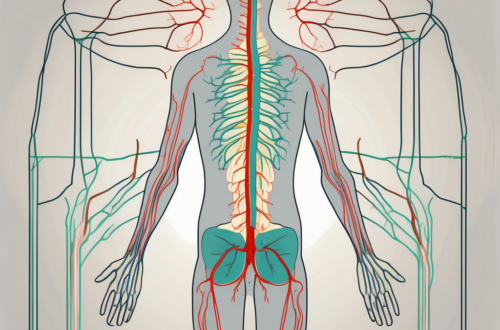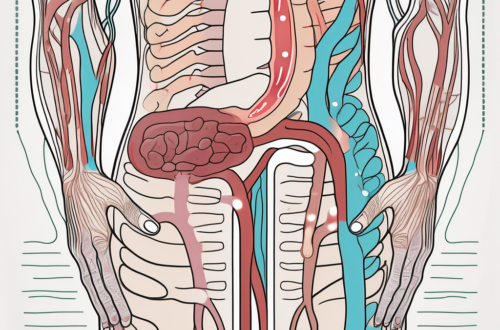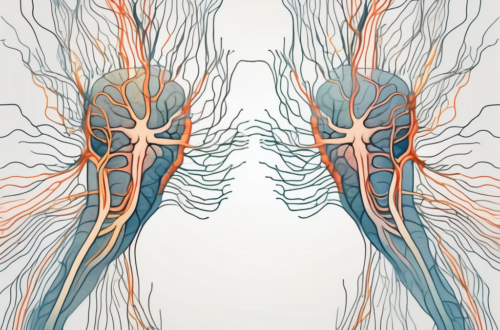The human body is a complex system of interconnected networks, each performing crucial functions to maintain balance and ensure efficient bodily processes. One essential system that plays a pivotal role in regulating various bodily functions is the autonomic nervous system (ANS). Within the ANS, two primary divisions work in harmony to achieve equilibrium – the sympathetic and parasympathetic nervous systems. Understanding how these divisions work together is key to comprehending the intricate balance within our bodies.
Understanding the Autonomic Nervous System
First and foremost, let’s delve into the autonomic nervous system itself. The ANS is responsible for regulating involuntary bodily functions, such as heart rate, breathing, digestion, and glandular secretion. It functions autonomously, meaning it works without conscious effort or control, allowing us to carry on with our daily activities without having to focus on these essential bodily processes.
The autonomic nervous system is a complex network of nerves and ganglia that extends throughout the body. It is intricately involved in maintaining the body’s internal environment, ensuring that all systems work together seamlessly. Without the autonomic nervous system, our bodies would struggle to adapt to changes in our surroundings and maintain a stable internal balance.
One fascinating aspect of the autonomic nervous system is its ability to respond to both external and internal stimuli. For example, when we encounter a stressful situation, the sympathetic division of the ANS kicks into gear, preparing our bodies for fight or flight. Our heart rate increases, blood vessels constrict, and adrenaline surges through our veins, all in an effort to help us respond to the perceived threat.
On the other hand, the parasympathetic division of the ANS is responsible for the “rest and digest” response. It promotes relaxation, conserves energy, and facilitates the digestion and absorption of nutrients. When we are in a state of rest, our parasympathetic nervous system takes over, allowing our bodies to repair and regenerate.
The Role of the Autonomic Nervous System
The primary role of the ANS is to facilitate communication between the brain and various organs, glands, and muscles throughout the body. By doing so, it ensures that bodily functions are harmoniously coordinated, maintaining homeostasis and responding to external and internal stimuli effectively.
Imagine a symphony orchestra, with each instrument playing its part to create a beautiful melody. In a similar way, the autonomic nervous system acts as the conductor, coordinating the different sections of the body to create a harmonious symphony of physiological processes.
Furthermore, the autonomic nervous system plays a crucial role in our body’s response to stress. When we encounter a stressful situation, the sympathetic division of the ANS prepares us for action, enabling us to respond quickly and effectively. This response is essential for our survival, as it allows us to escape from dangerous situations or confront threats head-on.
However, prolonged activation of the sympathetic nervous system can have detrimental effects on our health. Chronic stress can lead to a variety of health problems, including high blood pressure, weakened immune system, and digestive disorders. Therefore, it is important to find ways to manage stress and promote balance within the autonomic nervous system.
Components of the Autonomic Nervous System
The autonomic nervous system consists of two main divisions, each with a unique set of functions and responses. These divisions are known as the sympathetic nervous system and the parasympathetic nervous system.
The sympathetic nervous system is responsible for the body’s fight or flight response. When activated, it prepares the body for action by increasing heart rate, dilating blood vessels, and redirecting blood flow to the muscles. This response is crucial in situations where we need to react quickly, such as when facing a threat or engaging in intense physical activity.
On the other hand, the parasympathetic nervous system promotes relaxation and restoration. It helps to conserve energy, slow down heart rate, and enhance digestion. When we are in a state of rest, the parasympathetic division of the ANS takes over, allowing our bodies to recover and recharge.
Both the sympathetic and parasympathetic divisions of the autonomic nervous system work together to maintain a delicate balance within the body. They constantly adjust their activity levels based on the body’s needs, ensuring that all bodily functions are carried out efficiently and effectively.
The Sympathetic Nervous System Explained
Let’s explore the sympathetic nervous system, which is responsible for preparing our bodies in times of stress or emergency. It is often referred to as the “fight-or-flight” response system due to its role in activating our body’s physiological mechanisms to cope with threats or intense situations.
The sympathetic nervous system is a crucial component of our body’s autonomic nervous system, which controls involuntary bodily functions. It works in conjunction with the parasympathetic nervous system to maintain a delicate balance and ensure our body functions optimally.
The sympathetic nervous system is primarily controlled by a cluster of nerve cells called the sympathetic ganglia, which are located alongside the spinal cord. These ganglia receive signals from the brain and send out instructions to various organs and tissues throughout the body.
Function of the Sympathetic Nervous System
The main function of the sympathetic nervous system is to mobilize the body for action. When faced with a threat, such as encountering a predator or finding ourselves in a dangerous situation, this system rapidly triggers a series of physiological responses to ensure our survival.
One of the key actions of the sympathetic nervous system is to increase heart rate. By stimulating the heart, it ensures that oxygen-rich blood is pumped efficiently to the muscles and vital organs, preparing them for physical exertion. Additionally, it elevates blood pressure, ensuring an adequate supply of oxygen and nutrients reaches all parts of the body.
Another important function of the sympathetic nervous system is the dilation of airways. By relaxing the smooth muscles surrounding the bronchioles, it allows for increased airflow into the lungs, enhancing oxygen intake and optimizing respiratory function.
In times of stress or emergency, the sympathetic nervous system also releases glucose from the liver. This extra energy source provides fuel for the body’s increased metabolic demands during fight-or-flight situations.
The Sympathetic Response: Fight or Flight
During the fight-or-flight response, the sympathetic nervous system rapidly releases stress hormones, such as adrenaline and noradrenaline, into the bloodstream. These hormones trigger a cascade of physiological changes as the body readies itself to confront the perceived threat or flee from it.
Sweating is one of the immediate responses observed during sympathetic activation. This serves as a cooling mechanism, preventing overheating as the body prepares for physical exertion. Increased alertness and heightened senses are also common during this response, allowing individuals to be more aware of their surroundings and better equipped to respond to potential dangers.
Furthermore, the sympathetic nervous system enhances muscle strength. By increasing blood flow to the muscles and releasing additional energy, it enables individuals to exert more force and perform physical tasks with greater efficiency.
It’s important to note that while the fight-or-flight response is crucial for survival in acute situations, prolonged activation of the sympathetic nervous system can have negative effects on our overall health. Chronic stress and constant sympathetic arousal have been linked to various health issues, including cardiovascular problems, weakened immune function, and mental health disorders.
In conclusion, the sympathetic nervous system plays a vital role in preparing our bodies for action during times of stress or emergency. Its ability to mobilize resources and activate physiological responses ensures our survival in threatening situations. However, maintaining a balance between the sympathetic and parasympathetic nervous systems is essential for overall well-being and optimal bodily function.
Delving into the Parasympathetic Nervous System
Now that we have explored the sympathetic nervous system, let’s turn our attention to its counterpart, the parasympathetic nervous system. This system works in opposition to the sympathetic system to restore our body to a state of calm and relaxation, often referred to as the “rest and digest” response.
The parasympathetic nervous system is a crucial component of our autonomic nervous system, which controls involuntary bodily functions. It is responsible for regulating various physiological processes, ensuring that our body maintains a harmonious balance.
Function of the Parasympathetic Nervous System
The parasympathetic nervous system predominantly regulates bodily functions during periods of rest and recovery. Its primary role is to conserve and restore energy by promoting digestion, nutrient absorption, and overall relaxation.
When we are in a state of relaxation, the parasympathetic system takes charge. It orchestrates a symphony of physiological responses that work together to create an environment conducive to rejuvenation and restoration.
One of the key functions of the parasympathetic system is to stimulate the production of digestive enzymes and increase blood flow to the digestive organs. This allows for efficient breakdown of food and absorption of nutrients, ensuring that our body receives the nourishment it needs.
In addition to promoting digestion, the parasympathetic system also plays a vital role in regulating heart rate. When this system is dominant, heart rate decreases, allowing the heart to pump blood more efficiently and reducing the strain on this vital organ.
The Parasympathetic Response: Rest and Digest
When the parasympathetic system is dominant, heart rate decreases, blood vessels constrict, and digestion and metabolic functions are prioritized. The body enters a state of relaxation, allowing it to focus on nutrient absorption and tissue repair, thus facilitating optimal recovery and rejuvenation.
During this rest and digest response, the parasympathetic system also promotes the release of certain neurotransmitters, such as acetylcholine. These neurotransmitters help to calm the mind and enhance feelings of relaxation and well-being.
Furthermore, the parasympathetic system influences various other bodily functions, including salivation, lacrimation (tear production), and urination. It ensures that these processes occur smoothly, contributing to our overall well-being.
It is important to note that the parasympathetic and sympathetic systems work in a delicate balance, constantly adjusting to the needs of our body. While the sympathetic system prepares us for action and mobilizes energy, the parasympathetic system steps in to restore equilibrium and promote recovery.
In conclusion, the parasympathetic nervous system is a vital component of our body’s autonomic nervous system. It plays a crucial role in promoting relaxation, digestion, and overall well-being. By understanding the intricate workings of this system, we can appreciate the importance of rest and rejuvenation in maintaining a healthy and balanced life.
The Interplay Between Sympathetic and Parasympathetic Systems
While the sympathetic and parasympathetic divisions appear to function contrarily, they closely interact to maintain balance and adapt to the ever-changing demands of our environment. It is through this interplay that our bodies can respond appropriately to various situations and maintain overall well-being.
The sympathetic and parasympathetic systems are two branches of the autonomic nervous system, which controls involuntary bodily functions. The sympathetic system is often referred to as the “fight or flight” response, as it prepares the body for action in times of stress or danger. On the other hand, the parasympathetic system is responsible for the “rest and digest” response, promoting relaxation and recovery.
Balancing Act: Sympathetic and Parasympathetic Systems
In a healthy individual, both the sympathetic and parasympathetic systems work together in a delicate equilibrium, seamlessly transitioning between states of heightened activity and rest. This balance allows our bodies to respond efficiently to stressors when necessary while also prioritizing recovery and relaxation.
Imagine a tightrope walker, carefully maintaining balance as they traverse a thin wire. Similarly, the sympathetic and parasympathetic systems perform a delicate balancing act within our bodies. When faced with a stressful situation, such as encountering a predator, the sympathetic system kicks into gear. It increases heart rate, dilates blood vessels, and diverts blood flow to the muscles, preparing us for fight or flight. Once the danger has passed, the parasympathetic system takes over, slowing heart rate, constricting blood vessels, and promoting digestion and rest.
This seamless transition between the two systems is crucial for our overall well-being. It allows us to respond appropriately to stressors without compromising our ability to recover and recharge. Without this balance, our bodies would be in a constant state of heightened alertness or relaxation, leading to detrimental effects on our health.
How These Systems Influence Our Health
The intricate interplay between the sympathetic and parasympathetic divisions has profound effects on our overall health and well-being. A well-regulated autonomic nervous system promotes resilience, optimal organ function, efficient digestion, and adequate stress response. Conversely, an imbalance in these systems can contribute to various health issues, such as cardiovascular disorders, gastrointestinal problems, sleep disturbances, and emotional dysregulation.
When the sympathetic system is overactive, it can lead to chronic stress, which has been linked to an increased risk of cardiovascular diseases. The constant release of stress hormones, such as cortisol, can cause blood pressure to rise, impair blood vessel function, and contribute to the development of atherosclerosis. Additionally, an overactive sympathetic system can disrupt normal digestion, leading to gastrointestinal problems such as acid reflux, irritable bowel syndrome, and ulcers.
On the other hand, an underactive sympathetic system can result in poor stress response and emotional dysregulation. Individuals with an imbalance in these systems may experience difficulty in coping with stress, leading to anxiety disorders, depression, and mood swings. Furthermore, an underactive sympathetic system can also affect sleep patterns, as it plays a role in regulating the sleep-wake cycle. Sleep disturbances, such as insomnia or excessive daytime sleepiness, can have a significant impact on overall health and quality of life.
It is clear that the interplay between the sympathetic and parasympathetic systems is vital for maintaining our health and well-being. By understanding the delicate balance between these two systems, we can strive to promote their harmony through various lifestyle interventions, such as stress management techniques, regular exercise, and adequate sleep. Taking care of our autonomic nervous system is essential for achieving optimal health and resilience in the face of life’s challenges.
Disorders Related to Sympathetic and Parasympathetic Imbalance
Understanding the potential disorders arising from an imbalance in these systems is essential for identifying symptoms and seeking appropriate medical guidance. It is crucial to remember that only a qualified healthcare professional can provide an accurate diagnosis, and seeking their advice is advisable for personalized treatment plans.
Symptoms of Imbalance
An imbalance in the sympathetic and parasympathetic systems can manifest in various ways. Symptoms may include irregular heart rates, excessive sweating, digestive disturbances, sleep disorders, chronic fatigue, mood swings, and anxiety. These symptoms should not be self-diagnosed but taken note of and discussed with a healthcare professional to receive expert guidance.
Treatment and Management of Imbalance
Treatment and management options for an imbalance in these systems will depend on the individual’s specific condition and symptoms. Consulting a healthcare professional is essential to receive an accurate diagnosis and develop a personalized treatment plan. Depending on the situation, treatment options may include lifestyle modifications, stress reduction techniques, medication, or other targeted therapies.
The Future of Neurological Research
Advancements in neurological research continue to shed light on the complex interplay between the sympathetic and parasympathetic nervous systems. Ongoing studies aim to deepen our understanding of these systems’ intricate mechanisms and explore potential implications for enhancing health and improving medical interventions.
Current Research Trends
Current research trends in the field of neurology are unveiling promising avenues of exploration. Researchers are investigating the influence of lifestyle factors, such as diet, exercise, sleep, and stress management, on autonomic balance. Additionally, advancements in neuroimaging techniques allow scientists to visualize brain activity during autonomic responses, providing valuable insights into the functioning of these crucial systems.
Potential Implications for Health and Medicine
Exploring the interplay between the sympathetic and parasympathetic systems has the potential to revolutionize approaches to healthcare and medicine. By understanding these intricate networks, healthcare professionals can develop targeted interventions and therapies to address autonomic imbalances, potentially improving outcomes for individuals with conditions impacted by these systems.
In conclusion, the sympathetic and parasympathetic divisions of the autonomic nervous system work collaboratively to maintain equilibrium within our bodies. This delicate interplay allows us to respond efficiently to stressors while also promoting recovery and relaxation. Understanding the role of these systems and recognizing the potential signs of imbalance is crucial for fostering optimal well-being. It is important to remember that individual experiences may vary, and consulting with a healthcare professional is advisable for personalized guidance and support.





